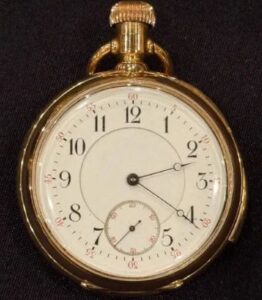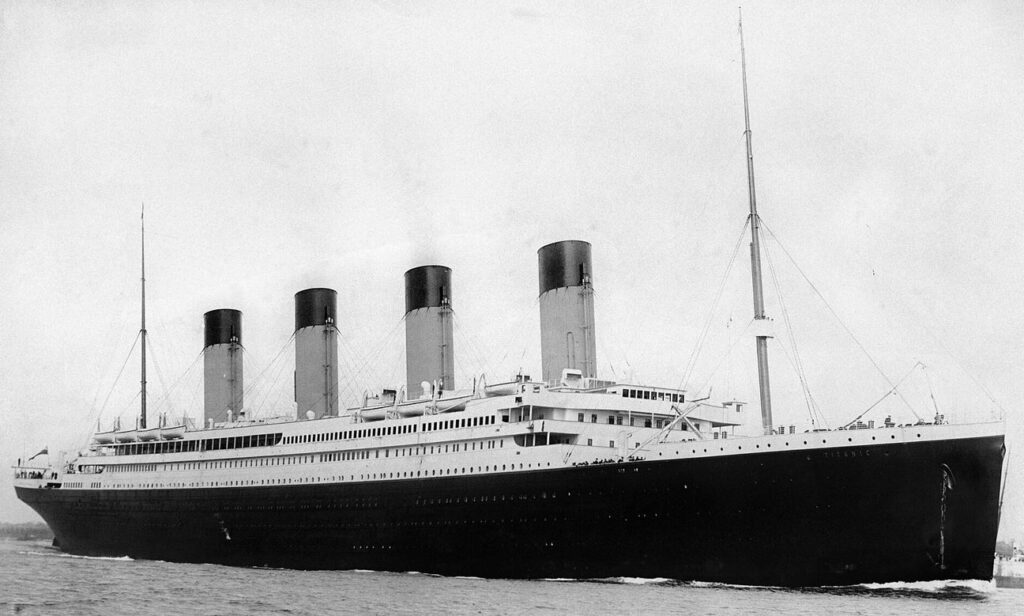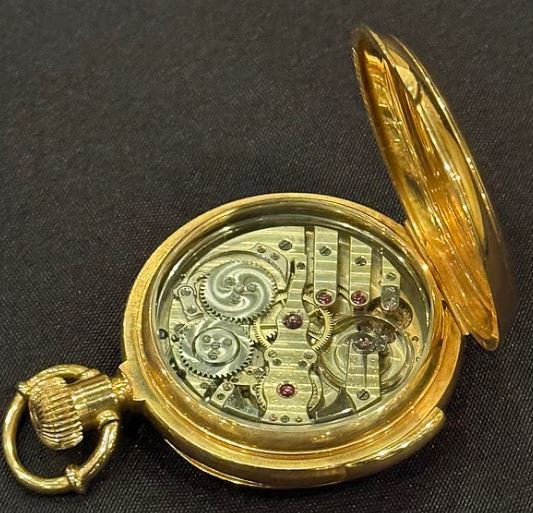Last updated on November 17, 2025
This was an interesting piece of news that was shared amongst the Time Worn Watches group. It is an 18-carat solid gold pocket watch made by the watchmaker Jules Jürgensen, which was a surviving relic of the sinking of the Titanic. The watch belonged to a wealthy passenger on the Titanic, Isidor Straus. The watch is being auctioned by Henry Aldridge & Son Ltd on the 22nd November 2025 and is expected to receive offers of around £1 million. Here is what we discovered when researching the news.
The Titanic
The RMS Titanic was a British ocean liner that sank on its maiden voyage in April 1912. Launched from Southampton on 10 April 1912. Harland and Wolff built the Titanic, the largest ship afloat at the time, to the highest luxury standards.. Late on 14 April, the ship struck an iceberg in the North Atlantic. The Titanic went down in the early hours of 15 April 1912. Of the roughly 2,224 passengers and crew aboard, more than 1,500 perished. This made the sinking one of history’s deadliest peacetime maritime disasters. The Titanic carried many of the richest and most famous people of the age. However, it also carried hundreds of emigrants seeking a new life in America. The sinking of the “unsinkable” ship spurred major reforms in maritime safety (including sufficient lifeboats and round-the-clock radio watch). Additionally, it left an enduring legacy in culture and memory (Titanic at Wikipedia).
Isidor Straus
The watch is a direct tie to the life of Isidor Straus (February 6, 1845 – April 15, 1912). Born into a Jewish family in Bavaria in 1845, Straus emigrated to the United States in 1854 and rose to become a major figure in American retail. He became a successful businessman, politician, and, most famously, the co-owner of Macy’s department store in New York. Straus embodied the American Dream. His passage on the Titanic in 1912 reflected his stature in the New York establishment (Isidor Straus at Wikipedia).
The watch itself marked a major professional and personal event. Ida Straus gave her husband the pocket watch in 1888. It commemorated both his 43rd birthday and his entry into partnership at Macy’s department store. An engraving bearing the date “February 6th 1888” and Straus’s initials confirms the watch’s origin as a deeply personal gift.
The sinking of the Titanic
Isidor and Ida Straus travelled first-class, enjoying the ship’s luxurious amenities. Their story achieved enduring fame due to their actions during the sinking. When the time came for evacuation, Isidor, then 67, refused a place in a lifeboat, upholding the conduct of the time of “women and children” first. His devoted wife, Ida, then famously refused to leave his side. She made the choice to die with her husband, declaring, “Where you go, I go”. This act of devotion became immortalised in popular culture, even appearing as a cameo in James Cameron’s 1997 film Titanic.
Following the sinking, the cable ship Mackay-Bennett recovered Isidor’s body, cataloguing it as Body #24. The recovery team meticulously documented and eventually returned his personal effects, including the gold pocket watch, to his family. Ida’s body was never found. The family memorialised the couple on a cenotaph in the Bronx. Inscribed on the centotaph is a quote from the Song of Solomon: “Many waters cannot quench love—neither can the floods drown it”. The watch is now being sold by the Straus family for the first time. It is expected to become one of the most expensive Titanic relics ever sold.
Jules Jürgensen watchmaker
The Jürgensen family business dates back to 1740 in Denmark, when Jürgen Jürgensen (father of Urban Jürgensen) set up shop in partnership with Isaac Larpent. Under Urban and his sons, the firm became famous for precision timepieces. One of Urban’s sons, Jules Frederik Jürgensen (1808–1877), later established a branch in Switzerland that bore his name. Over the following century, the company grew in renown. In 1919, the Swiss business was acquired by the Heuer Watch Company, which supplied movements and assembly for Jules Jürgensen watches. American owners took control of the brand in 1936, though they continued to manufacture watches in Switzerland into the 1950s. By the late 20th century, the Jules Jürgensen name had changed owners several times, and production eventually ceased. Their history and craftsmanship now make surviving pieces valuable to collectors. (Jules Jürgensen at Chronopedia).
The movement would represent the peak of 19th-century watchmaking. It would likely employ a high-grade nickel bridge-style movement. These calibres featured a precise lever escapement, ensuring accuracy and reliable timekeeping. High-end movements of this complexity typically incorporate at least 17 jewels to minimise friction. Typically, Jurgensen utilised white porcelain dials, frequently single-sunk, displaying legible Roman numerals and highly refined Breguet hands. The signature “J. Jurgensen” or “Jules Jurgensen” appears prominently on the dial and the movement.
The Titanic pocket watch
The Titanic pocket watch is a fine example of Jules Jürgensen’s work. It is an 18-carat solid gold pocket watch originally accompanied by a decorative chain. The watch’s case back is engraved with Straus’s initials “I.S.”. Additionally, the case interior bears the date 6 February 1888 (Isidor’s 43rd birthday). When it was recovered from Isidor Straus’s body, the watch’s movement had stopped at roughly 2:20 am. This is thought to be almost the very minute the Titanic foundered, freezing its hands at the moment of catastrophe. This poignant detail underscores the watch’s direct link to Titanic’s final hours. Recovering crews turned over the watch and Isidor’s other belongings to the Straus family. As noted in contemporary reports, these personal effects, including the Jules Jürgensen timepiece, were logged and returned to his son.
The watch has remained in the Straus family ever since. In recent decades, Straus’s great-grandson, Kenneth H. Straus (a former Macy’s executive and New York philanthropist), even had the movement carefully restored so that it would run again. (The family has included a historic letter written by Isidor aboard the Titanic.) Together, the timepiece and accompanying documents form a remarkable family archive of the Strauses’ final voyage (Titanic gold pocket watch at Global News).
Summary
The Isidor Straus pocket watch stands as one of the finest and rarest relics to emerge from the Titanic tragedy. It connects a high-profile passenger’s life and death to the broader story of the Titanic. Experts note that timepieces carried by passengers became a notable collecting category – watches were among the most valued personal items of the era and, being sturdy, could survive a wreck. The Straus watch, in particular, embodies both technological and human history. It is literally frozen at the moment the Titanic sank, and it represents the devotion of a couple who chose to face death together. We will follow up on the auction results.
Related content
Henry Aldridge & Son Ltd are one of the South West’s premier auctioneers of antiques and collectors’ items. It is a family-run business operated by husband and wife team Andrew and Chrissie Aldridge.



